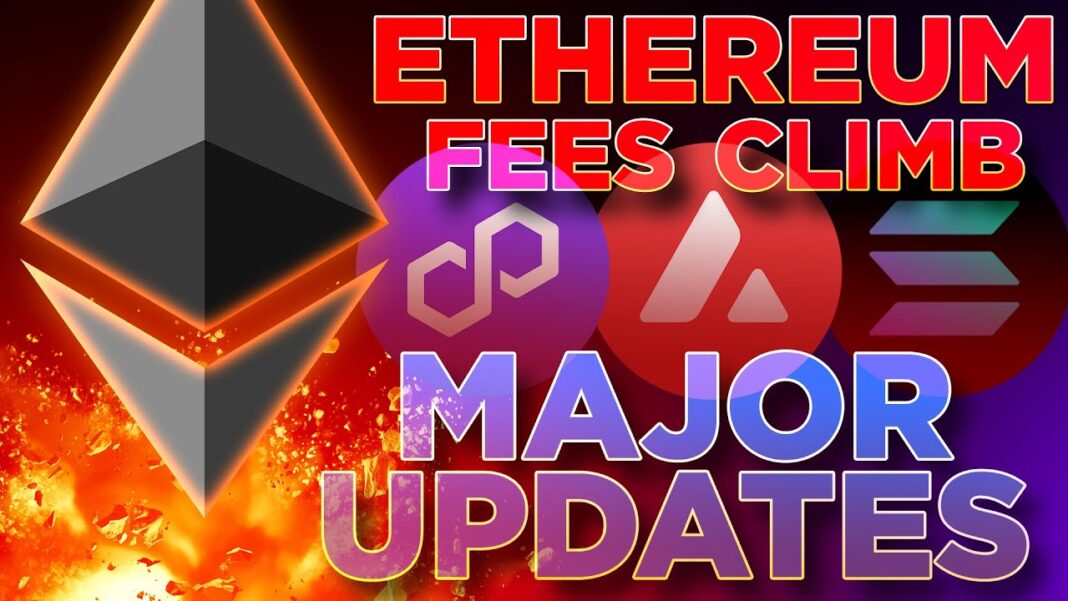Ethereum Gas Fees Climb🔥Layer-2 + Solana MAJOR UPDATES
Hey there, fellow crypto enthusiasts! It’s time to dive into the latest developments in the world of blockchain and cryptocurrency. In today’s blog post, we’ll be tackling a couple of significant topics: the soaring gas fees on the Ethereum network and the latest updates from Layer-2 solutions, along with some exciting developments on the Solana blockchain. So, grab a cup of coffee and let’s get started!
Ethereum Gas Fees Soar: What’s Causing the Surge?
If you’ve been actively using decentralized applications (dApps) or trading on decentralized exchanges (DEXs) on the Ethereum network recently, you’ve likely noticed a sharp increase in gas fees. Gas fees are the transaction fees paid to Ethereum miners for processing and validating transactions on the network. So, what’s behind the surge in gas fees, and how is it impacting Ethereum users?
1. Increased Network Activity
One of the primary reasons for the surge in gas fees is the increased network activity on the Ethereum blockchain. As decentralized finance (DeFi) protocols, NFT marketplaces, and other dApps continue to gain popularity, the demand for block space has surged, leading to congestion and higher gas fees. This increased network activity is a testament to Ethereum’s growing adoption but also highlights the scalability challenges facing the network.
2. Ethereum Improvement Proposals (EIPs)
Several Ethereum Improvement Proposals (EIPs) aimed at optimizing gas efficiency and improving network scalability are currently under development. EIP-1559, in particular, proposes a new fee structure that includes a base fee burned with every transaction, potentially reducing gas fees and making them more predictable for users. However, the implementation of EIP-1559 and other scalability solutions may take time, leaving Ethereum users to grapple with high gas fees in the interim.
3. Layer-2 Solutions as a Scalability Solution
Layer-2 solutions offer a potential solution to Ethereum’s scalability challenges by offloading transactions from the main Ethereum blockchain onto secondary chains or sidechains. These Layer-2 solutions promise lower transaction costs and faster confirmation times, making them an attractive alternative for users looking to avoid high gas fees. Projects like Optimism, Arbitrum, and zkSync are among the leading Layer-2 solutions aiming to improve Ethereum’s scalability and usability.
Solana: Major Updates and Growing Ecosystem
While Ethereum grapples with scalability issues and soaring gas fees, other blockchain platforms are seizing the opportunity to attract users and developers with their faster and more cost-effective solutions. Solana, in particular, has been making waves with its high-performance blockchain and rapidly expanding ecosystem. Here are some of the latest updates from the Solana ecosystem:
1. Solana Ecosystem Projects
The Solana ecosystem has seen a surge in new projects and decentralized applications (dApps) leveraging its high throughput and low transaction costs. From decentralized exchanges (DEXs) and non-fungible token (NFT) marketplaces to gaming platforms and decentralized finance (DeFi) protocols, the Solana ecosystem offers a diverse range of opportunities for developers and users alike. Projects like Serum, Mango Markets, and Audius are just a few examples of the vibrant ecosystem emerging on Solana.
2. Solana Mainnet Upgrades
Solana’s development team has been actively working on improving the platform’s performance and scalability through a series of mainnet upgrades. These upgrades aim to enhance network stability, increase throughput, and optimize transaction processing, further cementing Solana’s position as a leading blockchain platform. The recent launch of Solana’s mainnet beta, dubbed “Tour de SOL,” marks a significant milestone in the platform’s evolution and sets the stage for future growth and innovation.
3. Solana’s Growing Community and Adoption
Solana’s growing community of developers, validators, and enthusiasts has played a crucial role in driving adoption and fostering innovation on the platform. With its fast and scalable infrastructure, Solana offers an attractive alternative to Ethereum for developers seeking to build decentralized applications (dApps) and users looking for a seamless and cost-effective blockchain experience. As Solana’s ecosystem continues to expand, its potential to disrupt the blockchain industry becomes increasingly evident.
Conclusion
In conclusion, the surge in gas fees on the Ethereum network underscores the pressing need for scalability solutions to address the growing demand for blockchain transactions. While Ethereum Improvement Proposals (EIPs) offer a potential long-term solution, Layer-2 solutions like Optimism and Arbitrum provide immediate relief for users seeking lower transaction costs and faster confirmation times. Meanwhile, platforms like Solana are capitalizing on Ethereum’s scalability challenges by offering a high-performance alternative with a rapidly growing ecosystem.
As the blockchain industry continues to evolve, it’s essential to stay informed about the latest developments and explore alternative solutions that offer improved scalability, usability, and cost-effectiveness. Whether you’re a developer building on Ethereum, a user navigating high gas fees, or an enthusiast exploring emerging blockchain platforms like Solana, there’s never been a more exciting time to be involved in the world of cryptocurrency.





